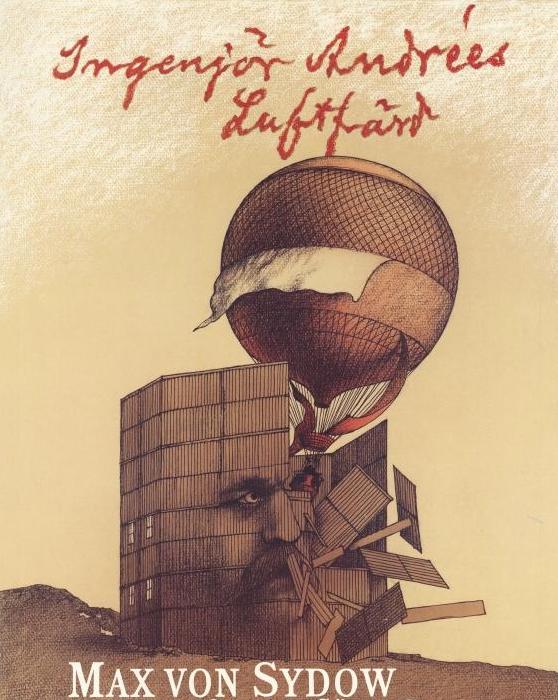Wednesday, May 18, 1983.
FLIGHT OF THE EAGLE (Ingenjör Andrées Luftfärd). Co-written by George Oddner, Ian Rakoff and Klaus Rifbjerg. Music by Hans-Erik Philip. Co-written, photographed, edited and directed by Jan Troell. Running time: 141 minutes. (Original running time: 180 minutes) In Swedish with English subtitles. Mature entertainment with no B.C. Classifier’s warning.
LIKE THE LITTLE ENGINE, Salomon August Andrée (Max von Sydow) thought he could. A true son of the 19th century, he believed in God, country and the broad uplands to which an enlightened science would lead mankind.
In 1896, Andrée convinced his King, Oscar II (Bruno Sörwing), and philanthropist Alfred Nobel (Ingvar Kjellson) that the Swedish flag was meant to fly from the North Pole. With their backing, he would plant it there himself.
On July 11, 1897, Ornen (The Eagle), Andrée's hydrogen gas-filled balloon, rose from the rocky shores of Spitzbergen. When the wait for a favourable south wind ended, the Flight of the Eagle began.
Director Jan Troell begins his examination of Ingenjör Andrées Luftfärd (literally, Engineer Andree's Air Voyage) with a title card announcing that this is "a true story." Archival photographs of frozen, partially decomposed bodies are followed by an image of a child freeing a trapped bird, an opening that forcefully foreshadows both the dream of free flight and its tragic consequences.
Troell, a dual Oscar nominee in 1972 for writing and directing The Emigrants, is particularly attracted to courageous dreamers. Using a technique of historical recreation that is close to docu-drama, he offers a low-key, non-histrionic tale that invites the filmgoer to take an active part in evaluating his characters.
Historically, engineer Andrée probably had much in common with another recent film subject, Brian Sweeney Fitzgerald, better known as Fitzcarraldo. As played by Klaus Kinski in director Werner Herzog's 1982 feature, the Irishman is the sort of raving maniac that a normal person would cross the street to avoid.
As played by von Sydow, the Swedish aeronaut has what writer Tom Wolfe calls "the right stuff." Despite public warnings from Andrée's former colleague Nils Ekholm (Jan-Olof Strandberg), both Nobel and the King are sufficiently charmed that they put their personal prestige on the line.
More significantly, Andrée's rectitude and certitude convince adventurer Knut Fraenkel (Sverre Anker Ousdal) and physicist Nils Strindberg (Göran Stangertz) that their lives will be safe in his company. Troell's film, punctuated with actual photographs taken by and of the balloonists, chronicles their expedition.
A 1982 nominee for the foreign-language film Oscar, Flight of the Eagle is a strikingly photographed, emotionally restrained look at a moment when a man's reach exceeded his grasp.
The above is a restored version of a Province review by Michael Walsh originally published in 1983. For additional information on this archived material, please visit my FAQ.
Afterword: Until 1867, only four nations could boast shorelines adjacent to the Arctic Ocean: Russia, Norway, Denmark (because Iceland and Greenland were held by the Danish Crown) and the United Kingdom (because Canada was a British Colony). The situation changed slightly on July 1 of that year when Britain’s North American colonies united into the not-quite independent federation called Canada. It changed significantly on October 18, the day that Tsar Alexander II transferred ownership of Alaska to the United States for $7.2 million.
Until 1957, Canadians gave little thought to our Arctic coast. Then, on August 1, Ottawa and Washington signed a joint defence agreement that added the acronyms NORAD (for North American Air Defence Command) and DEW (Distant Early Warning) Line to our Cold War vocabularies. In short order, 63 radar stations were built along the 4,800 km Arctic shoreline. By assuming the responsibility for our “defence” — from the threat of a trans-polar Soviet attack — our American friends effectively extended their Alaskan border all the way to Greenland.
Politically controversial in the early 1960s, NORAD faded from view soon after. Until 2022, it was just another dated pop-culture reference. We recalled media philosopher Marshall McLuhan saying that the role of the artist was to act as society’s “DEW line” during times of rapid social and technological change. Director John Badham set WarGames, his 1983 artificial-intelligence thriller, in the NORAD command centre. And every Christmas Eve since its formation, jolly television news anchors have followed the story as NORAD tracks Santa Claus during his annual flight from the North Pole.
On February 24, Russia invaded Ukraine. Three weeks ago (June 20), Canada’s defence minister announced a $40 billion NORAD modernization plan. And, once again, the nation’s cold coast is back in the news. As this latest Arctic thriller unfolds, we can only hope that our lives will be safe in the company of our Pentagon partners.
